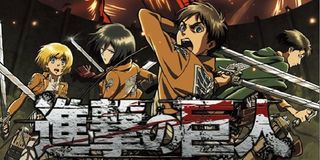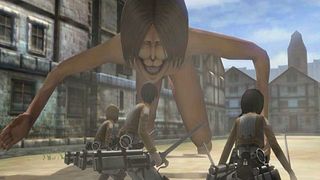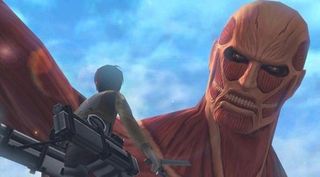Attack On Titan: Humanity In Chains Review: Swingin' And Slicin'

The city is being destroyed by giant, grotesque monsters and you are humanity's last line of defense. Zipping around the city like a medieval Spider-Man, you and your comrades must fight back against unfathomable odds and an enemy that cannot be reasoned with. Played solo or with up to three teammates, Attack on Titan: Humanity in Chains for the 3DS is an intriguing game of David vs. Goliath that sometimes soars and sometimes crashes into the side of a building.
Attack on Titan is one of those rare anime/manga that's managed to take the West by storm. The weekly series ran its course in early 2014, with a second season due out sometime in 2016. What made Attack on Titan stand out from the pack was its unique story, a fantastic soundtrack and some of the best action sequences ever animated. The show does a good job of putting humanity's desperation front and center while still providing a glimmer of hope that pushes the characters, and the viewer, from one seemingly impossible task to the next.
Attack on Titan: Humanity in Chains manages to capture several of those aspects admirably on the 3DS while falling woefully shy in other areas. It's a game of extreme opposites, demonstrating clever design and occasionally brilliant moments in a package that, overall, feels rushed to market in order to capitalize on the popularity of the series. Its one of those games where I can't help but wonder what an additional six months in the oven would have yielded.
For those unfamiliar with the series, Attack on Titan is set in a city that serves as mankind's last stronghold against the titans; these giant, humanoid creatures that seem to be driven by only one desire: Kill, smash and/or consume the tiny humans. After years of peace, a massive titan appears out of nowhere and destroys the first of three walls protecting the city from these monsters. All hell breaks loose, a lot of people die, and folks are forced to retreat behind the city's second wall.
Eren Jaeger and his friends, Mikasa and Armin, lose their homes and families in that initial attack, leading them to join the military in hopes of one day helping fight back against the titans. Humans may be tiny, but titans have a weak spot on the back of their neck. Cut off a chunk of flesh there and, boom, problem solved. To do that, Eren and company use these radical swords and even more radical “Omni-directional Mobility Gear.” Called OMG for short, these bad boys allow the military to zip around the city, swing around corners and launch themselves at a titan in the hopes of landing a killing blow.

Humanity in Chains tells much of the story from the anime's first season, kicking off at the point where Eren and his pals are combat ready and set to go out on missions. Eren, Mikasa and Armin have their own story branches, with a couple of show favorites, Levi and Sasha (Potato Girl!), thrown in for good measure. Each chapter is accompanied by a short scene from the show, as well as a bit of flavor text to help flesh out the details. Those details are pretty light overall, leading me to believe that Humanity in Chains' story mode was built assuming that the player has already seen the show and will be able to piece together any missing information on their own.
The story mode is also extremely short, taking about five hours to clear through all five characters. That wouldn't be too big of an issue if it wasn't for the fact that many of the missions are simply repeated for the different characters. The three members of the main cast were involved in the first expedition outside the outer wall, for instance, so you'll play that mission for all three characters with little variation between them. All three needed to defend the female titan when she was captured in the forest so, again, all three will play that mission.
CINEMABLEND NEWSLETTER
Your Daily Blend of Entertainment News
To make matters worse, there are only a handful of mission types to begin with, half of which aren't all that exciting. Each character has an escape on horseback or two, which involves you guiding your mount around a level and running through checkpoints. That's it. There are also “search” missions, which require you to scour the landscape in order to find armbands, potatoes and the like. These items are displayed as small glowing orbs. When you're zipping around the city or riding around the completely open fields, those tiny items can be extremely difficult to locate. Finally, there are the missions where you get to wage war as a titan yourself. You'd think these brawls would be the game's crowning jewel, but they come off extremely bland. You can block and dodge, but there's no need for any of those actions when landing the same three-punch combo over and over again will carry you to an easy win.
The rest of the missions involve slight variations on “kill the titans.” You'll either need to kill X number of titans, kill titans while keeping them from entering a certain zone, or kill a specific titan that has been marked as your target. There's very little to do outside of your main goal, aside from smashing barrels and crates to collect resources. Your teammates will also occasionally be grabbed by a titan, meaning you should probably make a beeline to them and cut them free. Otherwise, it's kill, kill, kill the titan.
Like the core gameplay of swinging and slashing, as well as the mission types, the locations you'll be visiting aren't all that varied, either. You'll be fighting in the city, in the field or in the forest. The city offers the most options for tackling titans, as you're able to swing to your heart's content or run across the rooftops to get around more quickly. The forest allows for similar swinging, but you'll have to follow natural pathways in order to get to your objectives, as trees get in the way. In the plains, the horse allows for fast movement but, since there are no buildings or towering trees about, your movement is limited to tethering to a titan and pressing the attack.
About halfway through the campaign, you'll finally unlock World Mode, which is where you'll pour most of your hours into Attack on Titan. Here, you'll build and level a customizable character, equip your favorite gear and go on loads of additional missions. This section of the game has a lot in common with Monster Hunter, as you'll be killing loads of titans solo or with online friends in order to get more materials to make even better gear. You'll need to keep a stockpile of the basics (blades, gas for your OMG, healing items) while funneling funds into upgrading various facilities and, thus, creating better equipment. Collecting resources while out on missions becomes a must in the World mode, and you'll occasionally stumble upon a Survey Report that fills in even more of Attack on Titan's back story. While the campaign is bland, this mode is far more robust than I was expecting.
You have some additional equipment at your disposal in World missions, too, including firearms and traps. Unfortunately, neither of these pieces of equipment are as effective as simply swinging around and killing the titans with your sword and, again, shows where the team at Spike Chunsoft had some good ideas and maybe didn't take enough time to properly develop them. If you're willing to ignore the clock and just goof off in missions, though, these add at least a little extra variety to the mix. They aren't efficient, but they can be kind of fun to try out.
Despite all of this, I actually enjoyed much of my time with Attack on Titan: Humanity in Chains. The frustrating “search” missions can go die in a fire but, even though they are extremely limited, I found the slaying missions to be quite a bit of fun. Once you get used to the camera and movement, you can pull off quite a few maneuvers that look like they were ripped straight from the anime, easily the game's greatest achievement.
For the most part, you'll be hammering on the Y and X buttons. The Y button tethers you to an object and sends you flying straight at it. The X button triggers an attack animation, which requires you to hit the button a second time when your attack circle lines up with the Critical circle. Anything other than a critical has little impact on the titans, and chaining criticals together makes your target zone bigger and bigger. If you notice a titan is about to swat you out of the air, simply spin the thumbstick to send your character into a sort of death spiral. It makes landing an attack nearly impossible, but it keeps you from taking damage or getting grabbed. Outside of that, the left bumper lets you just swing around freely and, like most of the mechanics, it works very, very well.

As in the show, the only way to kill a titan is to slice off a chunk of its neck. This becomes much easier once you become comfortable with the controls, as you'll figure out how to swing your character around to the back and open up a shot at the weak spot. If the titan is being a nuisance, simply target their arms or legs to hack off a limb and slow them down. Also like in the show, these limbs will quickly grow back, so you'll want to use that brief opening to finish the job.
Your mileage with Humanity in Chains will depend exclusively on how much you enjoy killing titans, as there's very little meat on these bones outside of some fun mechanics that let you zip around the levels and murder enemies one after another. The game is also very easy, with later World missions providing the only real challenge. You can also turn on Brutal mode in World missions but, even then, the odds never feel stacked too high against you. You'll also eventually unlock an endless mode, which has you killing titans until you finally fall in battle.
Attack on Titan: Humanity in Chains is a tricky game to recommend. While almost every aspect of the game feels limited, I can't deny that I had quite a bit of fun taking out titan after titan in a never-ending line of attacks. The gameplay is rhythmic (helped along by the show's stellar soundtrack), serving as a relaxing distraction rather than a grueling war against seemingly insurmountable odds. And while some will be turned off by how short each mission is (a few minutes, tops), I think it suits the portable nature of the 3DS quite nicely, making Attack on Titan a good choice for when you want to squeeze in a couple missions on the train or while waiting for a movie to start.
I think fans of the show will want to grab Humanity in Chains as soon as it hits the eShop (Sorry, no physical release), and that crowd will likely be happy enough with what's on offer here. But I have a hard time imagining who the audience is outside of said fans. Humanity in Chains is far too light to pull away Monster Hunter diehards, for instance, and if you don't really dig the core loop of swing-kill-repeat, then you're going to be extremely disappointed by the lack of variety.
Humanity in Chains offers some exciting encounters, but even the joy of freely zipping around the city doesn't completely overshadow an extreme lack of variety and a handful of half-baked ideas. Perhaps not the best compliment you can pay a game, but this first swing at Attack on Titan, more than anything, has me excited about what a more thoughtful, fleshed-out sequel will have to offer.
This review is based on a 3DS download copy of the game provided by the publisher.
Players: 1-4
Platforms: Nintendo 3DS
Developer: Spike Chunsoft
Publisher: Atlus USA
ESRB: Mature
Rating:

Staff Writer for CinemaBlend.
Most Popular






